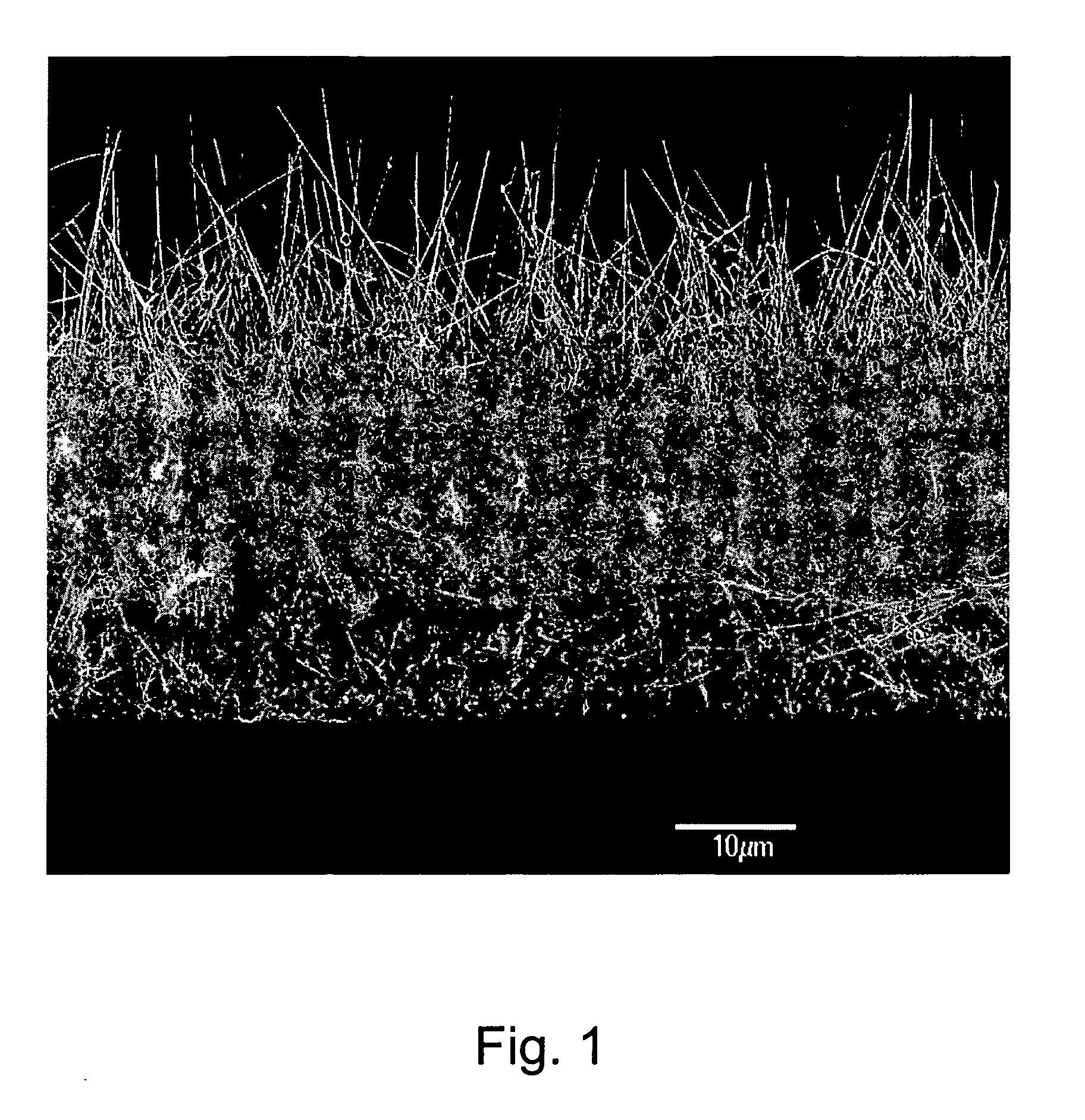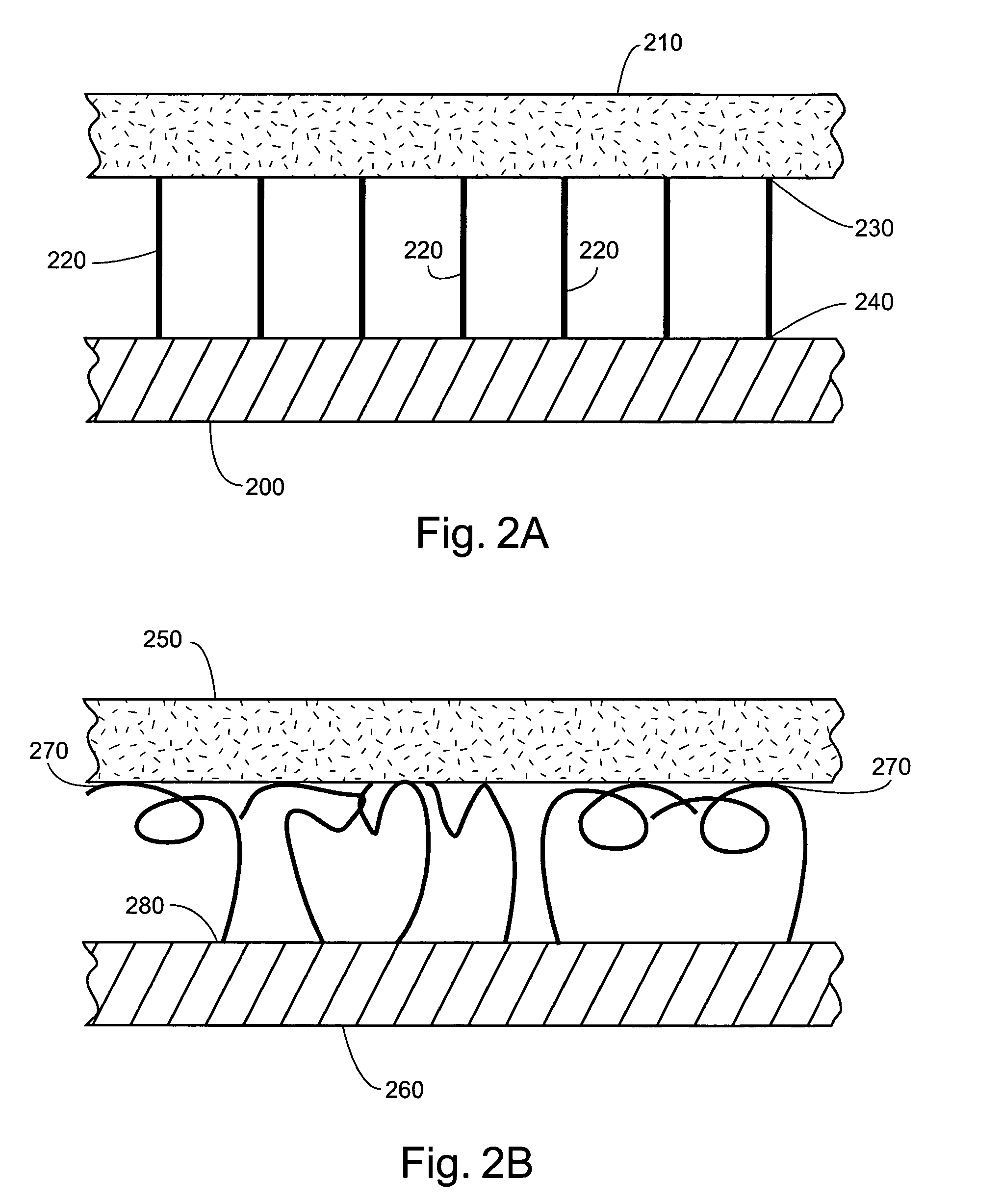Structures, systems and methods for joining articles and materials and uses therefor
a technology of articles and materials and structures, applied in the field of nanofibers and nanofiber structures, can solve the problems of inconvenient thickness of the adhesive layer needed to join the surface, inability to meet the needs of other directions, and inability to meet the needs of other directions, and achieve the effect of increasing the adherence (or adhesion) for
- Summary
- Abstract
- Description
- Claims
- Application Information
AI Technical Summary
Benefits of technology
Problems solved by technology
Method used
Image
Examples
example 1
Construction of an Adherent Nanofiber Substrate
[0105]Silicon nanofibers of approximately 40 nanometer in diameter and 50 um in length were grown on a four inch silicon wafer through a standard CVD process using gold colloids (see, e.g., above). The fiber density was approximately 2 nanofibers per square micron. To test the adhesion ability of the silicon nanofiber wafer, a microscope slide was suspended in a vertical orientation above a lab bench. A 2 centimeter×1 centimeter piece from the above silicon wafer containing the nanofibers was lightly pressed against the glass slide (with the nanofiber surface touching the glass slide). Thus, the top centimeter of the nanofiber wafer was exposed to the glass while the other centimeter was not in contact with the glass. A 200 gram weight was then attached to the free end of the silicon wafer via a binder clip. The weight was allowed to hang freely, thus, exerting a stress of 2 newtons on the nanofiber / glass interface. There was no measura...
example 2
Construction of an Adherent Nanofiber Substrate
[0106]Silicon nanofibers of approximately 40 nanometers in diameter and 50 um in length were grown on a 4 inch silicon wafer by the standard CVD process using gold colloids. See, e.g., above. The fiber density was approximately 2 nanofibers per square micron. To test the adhesion ability of the silicon nanofiber wafer to itself, two 2×1 centimeter pieces were cut from the silicon wafer containing the nanofibers. One centimeter of the fiber surface of each piece was lightly pressed together. One free end of the pressed pieces was clamped in a vice on a ring stand and a 100 gram weight was hung from the opposite end. The weight was allowed to hang freely, thus, exerting a stress of 1 newton on the nanofiber surface / nanofiber surface interface. There was no measurable movement in the nanofiber joints in 10 days.
example 3
Reuse of Adherent Nanofiber Substrates
[0107]The nanofiber substrate in Example 1 was pulled away from the glass in a perpendicular direction. It was then pressed against a second suspended piece of glass and through a similar process was shown to again hold 2 newtons of force.
PUM
| Property | Measurement | Unit |
|---|---|---|
| Pressure | aaaaa | aaaaa |
| Pressure | aaaaa | aaaaa |
| Pressure | aaaaa | aaaaa |
Abstract
Description
Claims
Application Information
 Login to View More
Login to View More - R&D
- Intellectual Property
- Life Sciences
- Materials
- Tech Scout
- Unparalleled Data Quality
- Higher Quality Content
- 60% Fewer Hallucinations
Browse by: Latest US Patents, China's latest patents, Technical Efficacy Thesaurus, Application Domain, Technology Topic, Popular Technical Reports.
© 2025 PatSnap. All rights reserved.Legal|Privacy policy|Modern Slavery Act Transparency Statement|Sitemap|About US| Contact US: help@patsnap.com



